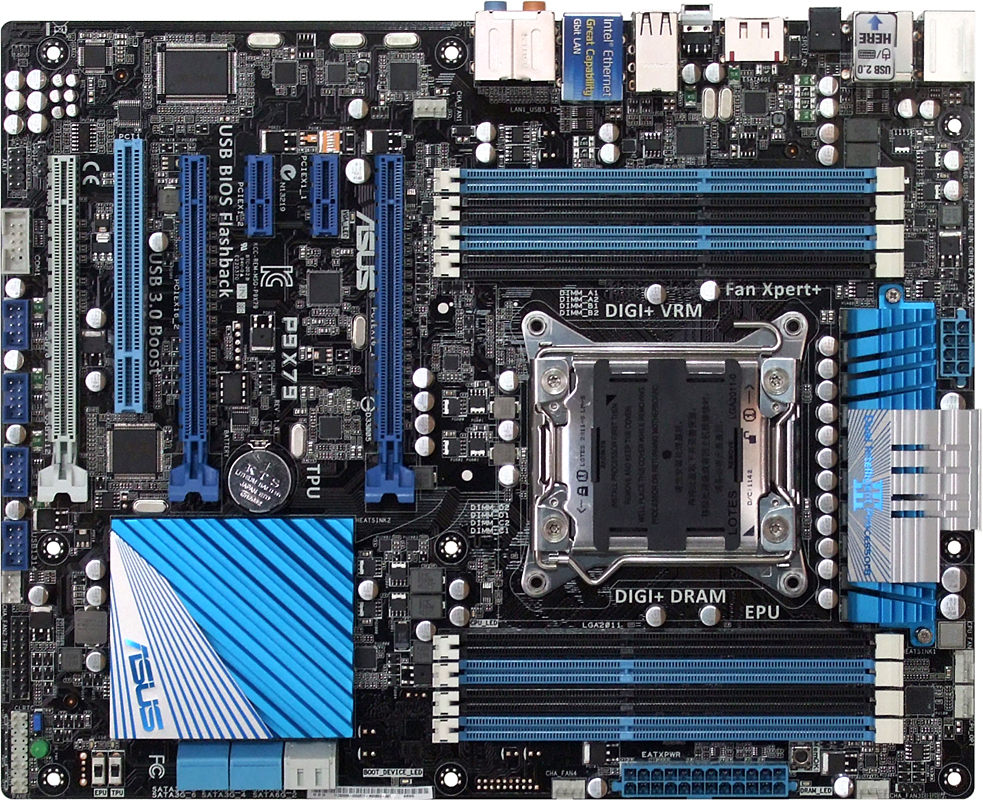Six $200-$260 LGA 2011 Motherboards, Reviewed
We know that Intel's X79 Express platform hosts the fastest desktop processors in the company's portfolio. But can it be made more affordable? We round up the least-expensive $200-$260 motherboards to determine how much you have to give up for cheap X79.
Asus P9X79
Asus puts all four of the P9X79’s USB 3.0 ports on the rear panel, eliminating the possibility of a front-panel header. The board does, however, retain eSATA and IEEE-1394 ports from its more-expensive siblings, along with Asus’ USB BIOS Flashback and Quick BIOS Screen Capture features.
USB BIOS Flashback uses a custom IC to enable firmware flashing from a USB drive with no other hardware installed. That’s particularly beneficial to users who actually need a firmware update to simply support hardware they bought with the board. As you'll see shortly, this is a very real concern, and a competitor was affected by its inability to accommodate our C2-stepping processor right out of the box.
The P9X79 beats several competing products in maximum memory support by including eight slots. While the board also gives up any additional SATA ports, most enthusiasts will expand beyond four modules long before they see the need to expand beyond the X79 Express' six SATA ports.
The P9X79 includes switches and a button for Asus’ EPU, TPU, and MemOK modes. EPU is an automatic underclocking routine for enhanced power savings under low loads, TPU is an automatic overclocking routine, and MemOK temporarily underclocks memory to ease booting with improperly-programmed modules.
Like most other entry-level X79-based platforms, the P9X79 relies on Sandy Bridge-E’s 40 PCIe 3.0 lanes to support up to three graphics cards with x16-x16-x8 connections. Asus pushes the x8 slot to the bottom of the board, however, where installing a dual-slot graphics card requires an eight-slot case (in addition to smashing flat any cables connected to headers along the board’s bottom edge). This is particularly frustrating for users who hoped to take advantage of Asus’ Q-Connector cable bundling feature. Dual-card users fare better, since the board provides an extra space between its two x16 slots for improved airflow.
Though the P9X79 supports three graphics cards, it does not include a three-way SLI bridge. A two-way SLI bridge, I/O shield, and four SATA cables complete its installation kit.
Get Tom's Hardware's best news and in-depth reviews, straight to your inbox.
-
I like Asrock boards. I have an 880GM-LE mATX and a Z68 Pro3 Gen3 ATX and both are good performance and price-performance wise.Reply
-
hellfire24 Asrock is dominating both high end and mid range market.extreme3/gen3 1155 is awesome and cheapest pci-e 3.0 sli capable mobo.Asrock FTW!!!Reply -
Achoo22 ReplyQuite simply, the costs associated with Sandy Bridge-E are higher, in part because of Intel's prices and also because the boards are more difficult to design.
Since the boards all have vastly superior profit margins, your statement is misleading. Why is everyone too afraid to reveal the truth about motherboard pricing? -
AlexIsAlex Would it be possible, in future motherboard reviews, to include a measure of the cold boot (POST) time? This is something that different bioses can be differentiated on, and UFEI offers the potential for very fast boots if manufacturers take advantage of it properly.Reply
A comparison of the time between the power button being pressed and the installed bootloader starting would be very interesting to me. I was thinking it might be easiest to measure this by having no OS on the boot media and measuring the time to the "please insert boot media" message, but I'm sure you can think of other ways of doing it.
I'm also informed that on some boards the boot time varies dramatically dependent on whether any Overclocking is enabled, as compared to the stock settings - that would also be worth knowing. -
americanbrian your feature table says the asrock extreme 4 comes with an 8 phase voltage regulator, but the text of article says 10 phase...which is it ?Reply -
KT_WASP crisan_tiberiuASRock = ASUSReply
not anymore, asrock is no longer affiliated with Asus and is owned by Pegatron Corp. -
memadmax I wish tom's would do a "best motherboards for the money" or something close to that.Reply



